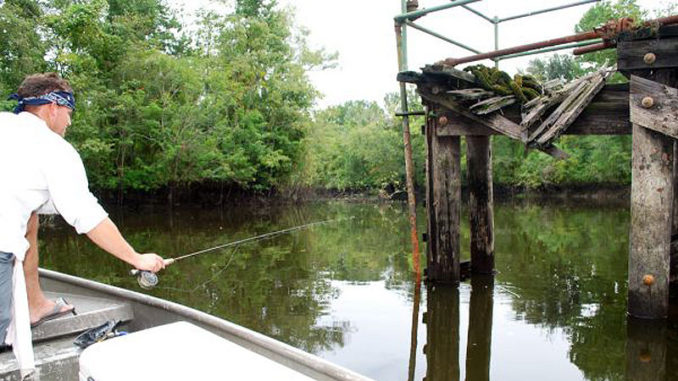
Although crappie — or sac-a-lait as Rhett Buteau knows them — will often move into open water, particularly late in the evening when they are feeding on midges, they are generally considered to be fish that like to hug cover.
Especially woody cover.
That’s where Buteau looks for them. He breaks sac-a-lait cover into four types: grass beds, bushes, laydowns, and wellheads.
Here’s how he approaches each type of cover:
Grass beds
What Buteau calls grass beds are really not grass at all, but rather beds of water hyacinths. He is choosy however, calling loosely floating beds of lilies “a waste of time.”
The grass beds he targets are obviously stationary and densely packed.
He fishes grass beds vertically, dropping his jig along the edges of the bed and through openings in the vegetation.
If there are no openings, his favored tactic is to use a “billy” (a small gardening rake attached a long bamboo pole) to pull open a very small hole in the lilies to drop his jig through.
For fishing grass beds, Buteau uses a 1/16-ounce jig, the only time he varies from his standard 1/32-ounce jig.
Bushes
Buteau fishes bushes both with a cork or with tight-lined jigs. He probes the outer edges of a bush, as well as its larger openings using a cork.
If the openings are tiny, he will temporarily shift to a rod rigged tight-line. These conditions and when winds are high enough (15 to 20 mph) to interfere with bait placement with a cork are the only times he fishes without a cork.
Laydowns
Trees that have fallen into the water are fished differently than bushes. Along their outside edges, Buteau works his jig sideways, preferably upcurrent, to give the jig a more horizontal presentation. His thought is that the jig imitates a minnow swimming in spurts against the current.
After fishing the edges, he shifts to the inside of the laydown, where to avoid hanging up he moves the jig vertically, similar to how he works a bush.
Wellheads
These are man-made structures, each holding one oil or gas well. Most are framed and protected with heavy wooden pilings and planks, although a few are bare metal casings protruding from the water.
These are the simplest of covers to fish and impossible to overlook. They are always fished with a cork.
Most typically, the jig is worked sideways, although he will sometimes jig vertically to vary the presentation.
Most wellheads are located in the center of dead-end canals, so the boat can be easily maneuvered around the structure several times to fish every nook and angle.
Buteau’s homemade corks are threaded onto the line using a length of stiff wire.
He varies the depth of the cork from 1 to 8 feet simply by sliding the cork up or down the line. The depth of the setting is dependent on where the fish are staging and the depth of the water.


